Life with Braces
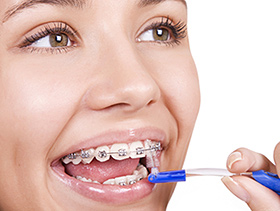
Oral hygiene with braces
When you have braces it's very important to brush and floss after every meal in order to keep your teeth and gums healthy throughout your treatment. If you need help choosing the right toothbrush, toothpaste, and dental floss, please ask us and we can help you choose the right products for your teeth and your appliance.
You'll also need to be careful about what you eat to prevent breaking your braces or bending the wires.
Brushing instructions
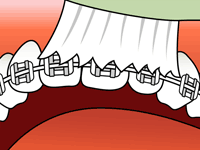
Brushing: step 1
Place your toothbrush at a 45-degree angle to your gum.
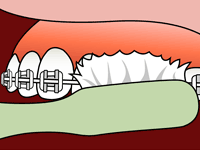
Brushing: step 2
Brush gently in a circular motion.
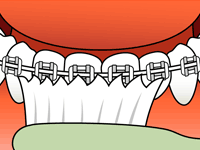
Brushing: step 3
Brush the outer, inner, and chewing surfaces of each tooth.
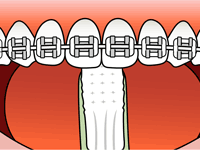
Brushing: step 4
Use the tip of your brush for the inner surface of your front teeth.
Flossing instructions
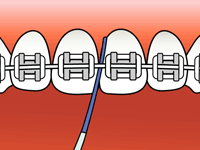
Flossing: step 1
Wind about 18 inches of floss around your fingers as shown. Most of it should be wrapped around one finger, and as the floss is used, the other finger takes it up.
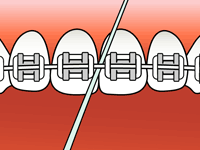
Flossing: step 2
Use your thumbs and forefingers to guide about one inch of floss between your teeth.
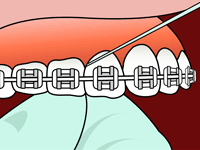
Flossing: step 3
Holding the floss tightly, gently saw it between your teeth. Then curve the floss into a C-shape against one tooth and gently slide it beneath your gums.
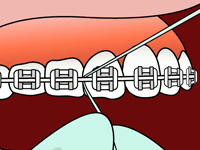
Flossing: step 4
Slide the floss up and down, repeating for each tooth.
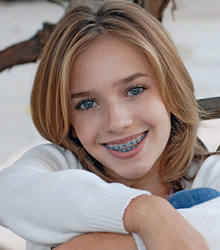
Eating with braces
Don’t worry: you’ll be eating popcorn and snacking on potato chips again in no time! Before you can start enjoying some of the treats you love, however, you will need to take special care to avoid any foods that could damage your new appliances.
Foods to avoid with braces:
- Chewy foods — bagels, licorice
- Crunchy foods — popcorn, chips, ice
- Sticky foods — caramel candies, chewing gum
- Hard foods — nuts, hard candies
- Foods that require biting into — corn on the cob, apples, carrots
Foods you CAN eat with braces:
- Dairy — soft cheese, pudding, milk-based drinks
- Breads — soft tortillas, pancakes, muffins without nuts
- Grains — pasta, soft cooked rice
- Meats/poultry — soft cooked chicken, meatballs, lunch meats
- Seafood — tuna, salmon, crab cakes
- Vegetables — mashed potatoes, steamed spinach, beans
- Fruits — applesauce, bananas, fruit juice
- Treats — ice cream without nuts, milkshakes, Jell-O, soft cake
Soreness caused by braces and appliances
When you first get your braces, you may notice your teeth and mouth feel a little tender or sore. This is perfectly normal for patients who have just gotten their braces put on, and we promise your mouth will not be sore forever! To relieve the pain, we recommend dissolving one teaspoon of salt in eight ounces of lukewarm water. Swish and gargle this solution in your mouth for just a couple of minutes, but do not swallow the salt water.
If the pain is more severe and does not go away after rinsing, you can also try taking a pain reliever. It is not uncommon for your lips, cheeks, and tongue to become irritated for one to two weeks as they toughen and become used to the braces. We would be happy to give you some wax you can put over them to lessen the tenderness. If you need some wax, please let us know!
Loose teeth
If your teeth begin feeling a little loose, don’t worry; this is normal! Your braces must first loosen your teeth in order to move them into the right position. Once your teeth have been repositioned, they will no longer be loose.
Loose wires and bands
The wires and bands on your braces may come loose. If this happens, please contact us as soon as possible so we can inspect and repair your appliance. If any piece of your appliance comes off, be sure to save it and bring it to the office with you.
You can temporarily reposition a loose wire or metal tie by using the back of a spoon or the eraser end of a pencil to push the wire carefully and gently back into place. If the loose wire is causing irritation to your lips or cheeks, put wax or a wet cotton ball over the broken wire to relieve the pain.
Take care of your appliances
Damaged appliances can increase the length of your treatment process, so be sure to take care of all your appliances. Your teeth and jaw can only move into their correct positions if you consistently wear the rubber bands, headgear, retainer, or other appliances prescribed by your doctor.
Playing sports with braces
Game, set, match — we have great news for athletes! You can still play sports even while undergoing orthodontic treatment! If you do play sports, it’s recommended you wear a mouthguard in order to protect your teeth and your appliance. Let your doctor know if you need help finding the right mouthguard for the best protection.
In case of a sports emergency, be sure to check your mouth and appliance immediately for any damage that may have occurred. If you notice any loose teeth, or if your appliance has been damaged, please contact our office right away. You can temporarily relieve the discomfort with wax or by rinsing your mouth with warm salt water.
Mouthguards protect your teeth and braces
Sports-related injuries to the mouth and jaw are among the most common damage suffered by athletes. Protecting your smile while playing sports is essential when you have braces. Mouthguards help protect your teeth and gums from injury. If you participate in high-contact sports, the American Association of Orthodontists recommends you wear a mouthguard. Be sure to ask your doctor about mouthguards at your next appointment.



